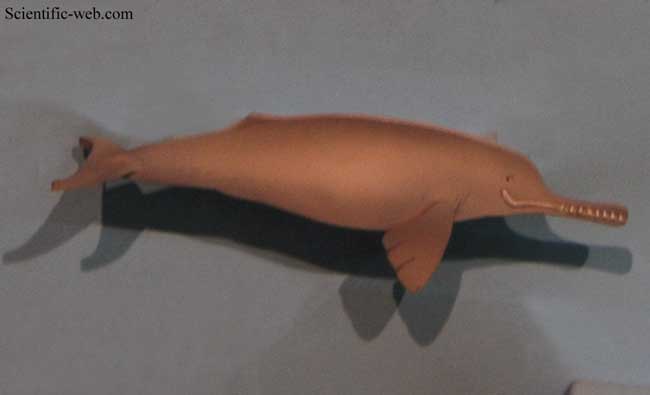Platanista minor, Photo: Michael Lahanas Cladus: Eukaryota Name Platanista minor Owen, 1853 Synonyms Platanista gangetica minor Owen, 1853 References * Platanista minor on Mammal Species of the World. Vernacular names --------------- The Ganges River Dolphin (Platanista gangetica gangetica) and Indus River Dolphin (Platanista gangetica minor) are two sub-species of freshwater or river dolphins found in Bangladesh, India, Nepal and Pakistan. The Ganges River Dolphin is primarily found in the Ganges and Brahmaputra Rivers and their tributaries in India, Bangladesh and Nepal, while the Indus River Dolphin is found in the Indus river in Pakistan and its Beas and Sutlej tributaries. From the 1970s until 1998, they were regarded as separate species; however, in 1998, their classification was changed from two separate species to subspecies of a single species (see taxonomy below). The Ganges river dolphin has been recognized by the government of India as its National Aquatic Animal.[2][3] * Both subspecies: South Asian River Dolphin, Blind River Dolphin, Side-swimming Dolphin
The species was described by two separate authors Lebeck and Roxburgh in the year 1801 and it is unclear to whom the original description should be ascribed [5]. Until the 1970s the Indus and Ganges River Dolphins were regarded as a single species. The two populations are geographically separate and have not interbred for many hundreds if not thousands of years. Based on differences in skull structure, vertebrae and lipid composition scientists declared the two populations as separate species in the early 1970s [6]. In 1998 the results of these studies were questioned and the classification reverted to the pre-1970 consensus of a single species containing two subspecies until the taxonomy could be resolved using modern techniques such as molecular sequencing. Thus, at present, there are two subspecies recognized in the genus Platanista, Platanista gangetica minor (the Indus dolphin) and Platanista gangetica gangetica (the Ganges River dolphin) [7]. Physical description The Ganges and Indus River Dolphins are essentially identical in appearance. They have the long, pointed noses characteristic of all river dolphins. The teeth are visible in both the upper and lower jaws even when the mouth is closed. The teeth of young animals are almost an inch long, thin and curved; however, as animals age the teeth undergo considerable changes and in mature adults become square, bony, flat disks. The snout thickens towards its end. The species does not have a crystalline eye lens, rendering it effectively blind, although it may still be able to detect the intensity and direction of light. Navigation and hunting are carried out using echolocation. The body is a brownish colour and stocky at the middle. The species has only a small triangular lump in the place of a dorsal fin. The flippers and tail are thin and large in relation to the body size, which is about 2-2.2 meters in males and 2.4-2.6 m in females. The oldest recorded animal was a 28 year old male 199 centimeters in length [8]. Mature adult females are larger than males. Sexual dimorphism is expressed after females reach about 150 cm; the female rostrum continues to grow after the male rostrum stops growing, eventually reaching approximately 20 cm longer. Calves have been observed between January and May and do not appear to stay with the mother for more than a few months. Gestation is thought to be approximately 9-10 months. The species feeds on a variety of shrimp and fish, including carp and catfish. Dolphins are usually encountered on their own or in loose aggregations; they do not form tight, obviously interacting groups. Both subspecies have been very adversely affected by human use of the river systems in the sub-continent. Entanglement in fishing nets can cause significant damage to local population numbers. Some individuals are still taken each year and their oil and meat used as a liniment, as an aphrodisiac and as bait for catfish. Irrigation has lowered water levels throughout both subspecies' ranges. Poisoning of the water supply from industrial and agricultural chemicals may have also contributed to population decline. Perhaps the most significant issue is the building of more than 50 dams along many rivers, causing the segregation of populations and a narrowed gene pool in which dolphins can breed. There are currently three sub-populations of Indus Dolphins considered capable of long-term survival if protected [9]. Both subspecies are listed by the IUCN as endangered on their Red List of Threatened Species [1]. The Indus River Dolphin is listed as endangered by the U.S. government National Marine Fisheries Service under the U.S. Endangered Species Act. The immediate danger for the resident population of P. gangeticus in National Chambal Sanctuary is the decrease in river depth and appearance of sand bars dividing the river course into smaller segments [10]. 1. ^ a b Smith, B. D. and G. T. Braulik (2008). Platanista gangetica. In: IUCN 2008. IUCN Red List of Threatened Species. Downloaded on 14 December 2008. Database entry includes justification for why this species is endangered General references 1. Randall R. Reeves, Brent S. Stewart, Phillip J. Clapham and James A. Powell (2002). National Audubon Society Guide to Marine Mammals of the World. Alfred A. Knopf, Inc. ISBN 0375411410. * Smith, B. D., G. T. Braulik and R. K. Sinha (2004). Platanista gangetica gangetica. In: IUCN 2004. IUCN Red List of Threatened Species. Downloaded on 14 November 2008. Source: Wikispecies, WIkipedia: All text is available under the terms of the GNU Free Documentation License |
|


